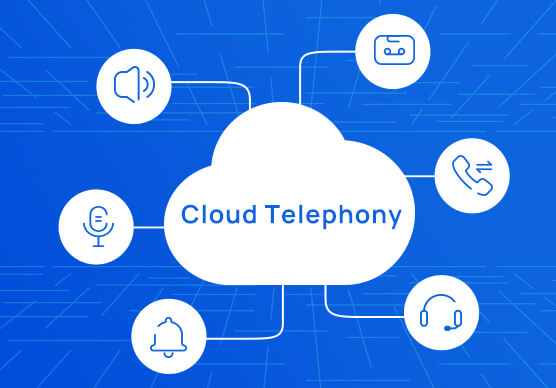
Cloud telephony is an advanced communications technology that eliminates the need for businesses to host their communication devices and applications on-premise. With cloud telephony, all these services are hosted by a service provider, sparing businesses from the hassle of installing software or purchasing hardware.
This technology encompasses a wide range of services, including interactive voice response (IVR), call routing call recording, virtual numbers, and call forwarding. By leveraging the power of the cloud, cloud telephony enables the seamless transmission of voice and data over the internet, bypassing traditional telephone lines.
It offers businesses unparalleled scalability and flexibility, allowing them to easily add phone lines and features to meet their evolving needs. Moreover, cloud telephony integrates smoothly with business applications and customer relationship management (CRM) systems, enhancing the overall communication experience.
This article unravels the inner workings of cloud telephony and unveils its transformative impact on modern businesses.
The Essence Of Cloud Telephony Software For Businesses Today
Effective communication is a fundamental pillar of thriving businesses, enabling streamlined operations and fostering strong customer relationships. Let’s explore why cloud telephony solutions have become an indispensable asset for businesses, enabling them to enhance productivity, improve customer experiences, and stay ahead in a competitive landscape.
Instant setup & business process continuity
With a cloud telephony software, businesses can enjoy a quick setup process, often completed within 24 hours or less. Organizations can swiftly transition to cloud-based communication solutions, ensuring uninterrupted operations and maintaining business process continuity.
For example, in a physical office relocation or unexpected circumstances like a natural disaster, entire call centers can be seamlessly moved to remote working solutions within a few hours, allowing agents to continue serving customers without disruption.
No hardware or maintenance costs
Cloud telephony eradicates businesses’ need to invest in hardware or equipment. By subscribing to a cloud service, organizations can avoid upfront installation and ongoing maintenance costs associated with traditional on-premises telephony systems. This allows businesses to allocate their financial resources to other vital areas, promoting cost efficiency and enabling better financial planning.
Easy Integrations
Cloud telephony software offers seamless integrations with various cloud software solutions, including popular platforms like Salesforce, HubSpot, Zoho, Zendesk, Freshdesk, and Slack. By integrating these systems, businesses can enhance productivity, streamline workflows, personalize calls and chats, unify customer data, and ultimately boost the overall customer experience.
For example, CRM integration givescall center agents instance access to relevant customer information enabling contextual conversations and personalized service.
Add new channels seamlessly
Customers expect multiple communication channels beyond traditional phone calls in today’s digital age. Cloud telephony enables businesses to respond to customer needs by incorporating additional channels such as SMS, WhatsApp, or Twitter with ease. By expanding communication options, organizations can enhance customer experience on their preferred channels, enhancing customer satisfaction and improving overall communication effectiveness.
Reports & insights
Cloud telephony solutions typically provides comprehensive reports and insights to businesses. These reports include live dashboards with real-time information on calls connected, call durations, agent workloads including time spent on calls and after call work as well as, average handle times.
Such detailed analytics enable businesses to monitor and evaluate call performance, identify trends, and make data-driven decisions to optimize operations, improve customer service, and enhance overall business outcomes.
How does cloud telephony work?
Cloud telephony software migrates the entire phone system to the cloud, transforming how businesses handle incoming calls. Instead of customers calling office lines directly, they dial a published cloud telephony number. When an incoming call is received, there are three possible scenarios for call forwarding:
Scenario 1: Call forwarding to a PRI (Primary Rate Interface) line in the data centre
In this scenario, the incoming call is forwarded to a PRI line in the data center. PRI lines are digital lines that carry voice and data signals, allowing multiple simultaneous calls. The cloud telephony software can efficiently manage to call traffic and distribute calls to the appropriate extensions or agents by forwarding the call to a PRI line in the data center.
Scenario 2: Call forwarding to a PRI number from the cloud
In this case, the incoming call is forwarded from the cloud to a PRI number, which may be located at the customer’s physical location or another designated destination. This allows businesses to have greater control over their telephony infrastructure while leveraging the benefits of a cloud telephony solution, such as call management features and scalability.
Scenario 3: Call forwarding to cloud telephony servers with multiple PRI lines
The incoming call is forwarded to cloud telephony servers with multiple PRI lines in this scenario. These servers have the capability to handle various functionalities such as call recording, interactive voice response (IVR), reporting, and API integrations. The cloud telephony servers can efficiently manage high call volumes by utilizing multiple PRI lines, ensuring smooth call handling and providing additional features and services.
Parting Thoughts
To fully harness the power of cloud telephony and maximize the potential for optimizing customer communications, businesses must carefully consider essential factors. This includes evaluating the platform’s capabilities, ensuring reliability, conducting trial runs to test functionality, prioritizing seamless transitions, and addressing data security concerns.
By considering these factors, businesses can make informed decisions and confidently embrace the transformative benefits of cloud telephony. With its ability to streamline communication processes, enhance scalability, and improve customer experiences, cloud telephony is poised to revolutionize how businesses engage with their audience in future years.





